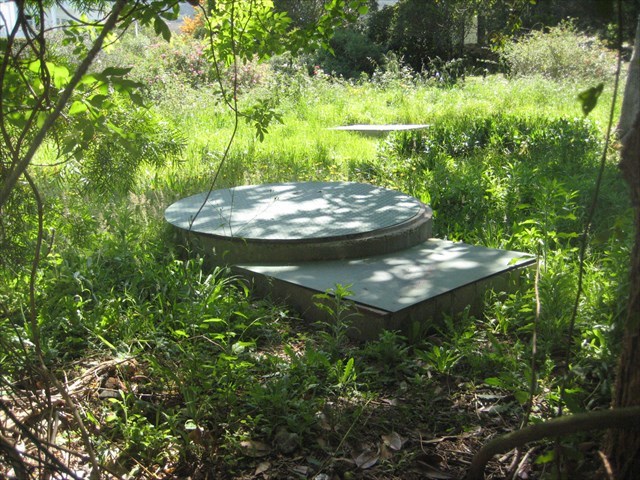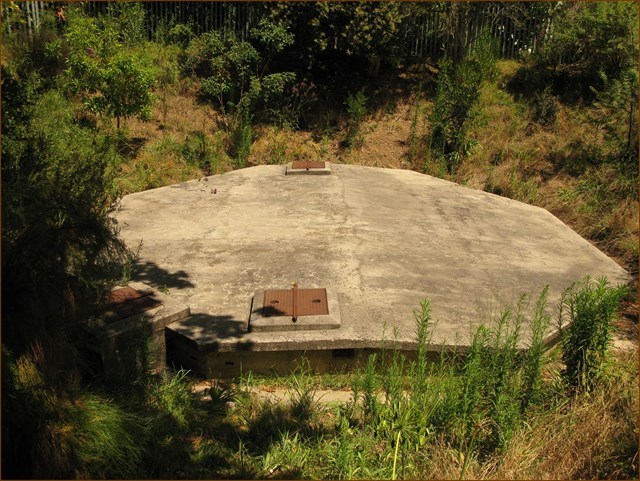Introduction
The waters that issue from the seeps and springs on the lower slopes of the eastern flank of Table Mountain have been used since pre-historical times. There are several historically important springs between Rondebosch and Kirstenbosch. Few people realise how these springs - geological features - have contributed to the early civic and industrial development of Cape Town's southern suburbs. The earth caches: Albion Spring (GC7DNQJ); The Kommetjie Spring (GC7DTJ7); and Kirstenbosch Spring (GC7DQOY); provide additional information on different aspects of the hydrogeology and historical importance of these springs. Before considering the particular hydrogeology of the Newlands springs their contribution to Cape Town's development will be briefly outlined.

1894 Sketch of Newlands Spring
Logging Requirements
TO CLAIM AND LOG A FIND FOR THIS EARTH CACHE YOU NEED TO ANSWER THE FOLLOWING QUESTIONS AND EMAIL YOUR ANSWERS VIA MY GEOCACHING PROFILE.
[Each member of a caching group must submit individual answers.]
ONCE YOU HAVE VISITED THE SITE AND ARE CONFIDENT THAT YOUR ANSWERS ARE CORRECT YOU MAY LOG THE SITE AS "FOUND". IF YOUR ANSWERS ARE NOT CORRECT YOU WILL RECEIVE AN EMAIL INFORMING YOU OF WHICH ANSWERS NEED TO BE CORRECTED TO VALIDATE YOUR LOG. AFTER 7 DAYS LOGS THAT HAVE NOT BEEN VALIDATED WITH ANSWERS WILL BE DELETED.
1. What type of analysis was used by Roger Diamond to determine that extremely local recharge on the lower slopes of the mountain is the source for the water emerging from the Newlands Springs?
2. Briefly explain why the common notion that an aquifer is an "underground lake" is incorrect.
3. In what way has the Table Mountain Group of rocks contributed to the recharge of the Newlands springs?
4. Select the correct answer from: a,b,c, d, or e.
(a) Isotopes are atoms with the same number of protons but a different number of neutrons;
(b) Atomic mass is the sum of protons and neutrons in an atom;
(c) Different isotopes of Hydrogen and Oxygen are present in natural water;
(d) Every rainfall has its own isotopic signature;
(e) All of the previous statements are correct.
5. Explain why water from the palmboom spring is no longer being used for domestic purposes.
6. There are two separate sources of spring water along Spring Way. Assuming the hidden source of the 'Brewery Spring' is 20 metres East of the road, determine through observation the approximate east to west distance between the source of the 'Brewery Spring' and the source of the 'City Council Spring'.
Please read the hint to help with this determination. A photograph of the source of the "Council Water" west of the road has been provided. Simple addition of three numbers gives the required answer.
The Newlands Springs' Contribution to Cape Town Suburban Development
In January 1660, Harman Remanjenne was granted a piece of land straddling the Liesbeek, this became known as Rouwkoop estate (the present day Roukoop Road in Rondebosch dates from this era and still straddles the Liesbeek), the estate remained undivided until 1815 when it was split into two, the portion east of the river retaining the name Roukoop and that to the west taking the name De Hoop. An 1816 diagram recording this land transaction clearly shows a spring on De Hoop. The water from this spring (today called the Albion spring) has contributed directly to the industrial and civic history of Rondebosch, Claremont, Mowbray, Woodstock, and Wynberg, while the Newlands spring has influenced the development of Newlands and Claremont.
In 1818 the owner of the Louwvliet estate in Newlands was granted permission to construct a dam across the Liesbeek. This was to be placed above the Westervoort Bridge and water would be lead from here to the Louwvliet mill (later to become known as Josephine Mill). To prevent disputes over water supply, an arrangement between the Louwvliet (Newlands) and De Hoop (Rondebosch) water-mills was made whereby they would take water from their respective dams on alternate days. This led to a further agreement by which water from the Louwvleit dam would be supplemented by water from the Newlands Spring, and used to drive the mill at Louwvliet, after which it would re-enter the Liesbeek to supply the sluice to the De Hoop mill down-stream. This arrangement optimised flow of water in the Liesbeek and the mill owners were not restricted to drawing water on alternate days. The two mills were the start of industrial activity in today's Southern Suburbs.
The clear water springs of Newlands have long been recognised as being a key factor in the history of the development of the suburb, and in the history of brewing in South Africa. When first settled the Newlands estates were entirely dependent on the springs for domestic and industrial use. The first brewery licence granted in 1694 was at Papenboom and utilised the Kommetjie spring [then known as Papenboom spring] for a supply of clear water for the brewing of beer. In 1840 Joseph Letterstedt established the Mariendahl Brewery adjacent to his water-mill. In 1866 Daniel Cloete founded a brewery that became known as Newlands Brewery. The Cannon Breweries were started by in 1874 by Dr Jonas Michael Hiddingh and in 1884 Anders Ohlsson bought the Anneberg Mill and converted the Mill into the Anneberg Brewery. All drew their water from one or other of the Newlands springs. All these breweries were acquired by Anders Ohlsson between the years 1888 and 1889. Ohlsson consolidated his properties and commercial interests forming Ohlsson's Cape Breweries. This was later to be incorporated into the S A Breweries, with headquarters at the Mariendahl Site.
The Hydrogeology of the Newlands Springs
Now that we have learned about the role that the springs have played in the development of the suburbs in which they occur we need to think about where this water comes from.
It comes out of the ground: yes, that is why it is called groundwater. But all water that seeps, flows, or is pumped out of the earth once fell as rain. Over time, water from rain, streams, and rivers moves down through the ground and is stored in the spaces between grains of soil or rock or in cracks and fissures in rocks. Underground layers of rock that are saturated with water that can be brought to the surface through natural springs or by pumping are called aquifers. The term aquifer is applied to geological units that conduct significant quantities of groundwater, geological units that do not permit groundwater to pass through them are termed aquitards. Groundwater is found in vast quantities and constitutes about 98% of the liquid fresh water on the planet. The study of groundwater and its movement is known as hydrogeology.
In 1933 the geologist H F Frommurze contributed a chapter "Underground Water Resources" to S F Haughton's Geological Survey monograph titled The Geology of Cape Town and Surrounding Country. Much of what he wrote about the aquifer feeding the springs has only been proved correct eighty years later by Roger Diamond using high-tec stable isotope analysis to determine the source of the springs' water.
In 2014 Roger Diamond's PhD thesis at the University of Cape Town gave close attention to the springs issuing from Table Mountain itself. Using stable isotope analysis of the spring waters, this study showed that the Table Mountain springs are on average recharged about 1km upslope of the spring and at an average elevation of 330m above sea level. The isotope ratios proved that a significant component of groundwater reaching the springs is from fast and shallow flow, although a deeper component must also exist to account for the steady discharge of and perennial nature of the springs. The study also showed that in feeding the springs the groundwater moves through the scree aquifer at between 15 and 20 meters per day.
Diamond's evidence points to extremely local recharge on the lower slopes of the mountain. The most likely aquifer for the southern suburbs springs is the scree and weathered material overlying the peninsula's basement rocks: granite near Kirstenbosch and Malmesbury Group rocks in Newlands and Rondebosch. The Table Mountain Group is not directly involved in the recharge of the Newlands springs, except as a supply of boulders and sand that make up the scree material on the slopes of the mountain.
In Newlands groundwater seeps to the surface in three recocnizable locations: (1) at Springs Way -- where the South African Breweries draw water east of the road and the city council collect water west of the road; (2) at Palmboom spring, on Palmboom road, north-east of Spring way; and (3) at Kommetjie spring, west of the Forrester's Arms.

The Newlands 'City Council' Spring 2017
The Basics of Stable-Isotope Hydrology
Isotope hydrology is a field of hydrology that uses isotope ratios to estimate the age and origins of water and its movement through the hydrologic cycle. This is especially useful for determining of the source and age of groundwater.
Isotopes are atoms with the same number of protons but that have a different number of neutrons. The atomic number is equal to the number of protons and the atomic mass is the sum of protons and neutrons, this means that isotopes are elements with the same atomic number but different mass numbers. Isotopes may be radioactive, or unstable (they decay to another state known as a daughter product), or stable. Common stable isotopes include hydrogen 2H/H, oxygen 18O/16O, and carbon 13C/12C. These isotopes occur naturally in the environment, but their natural abundance differs with different environmental conditions. Isotope-ratio Mass Spectrometers are used to determine the rations of the different isotopes of Hydrogen and Oxygen present in water samples.
Water molecules carry unique fingerprints, based in part on differing proportions of the oxygen and hydrogen isotopes that constitute all water. Water contains mostly oxygen 16 (16O). Oxygen 18 (18O) occurs in approximately one oxygen atom in every five hundred and is a bit heavier than oxygen 16, as it has two extra neutrons. This results in a preference for evaporating the lighter 16O containing water and leaving more of the 18O water behind in the liquid state (this natural separation of isotopes is called fractionation). Each rainfall or snowfall has its own isotopic signature.
As a result of the different isotopes, water can occur as nine different isotopologues, chemically identical but isotopically different molecules.
| Isotopologue |
Atomic Mass |
Abundance (%) |
| 1H1H16O |
18 |
99.73 |
| 1H1H18O |
20 |
0.200 |
| 1H1H17O |
19 |
0.038 |
| 1H2H16O |
19 |
0.015 |
| 1H2H18O |
21 |
0.00003 |
| 1H2H17O |
20 |
0.0000057 |
| 2H2H16O |
20 |
0.0000022 |
| 2H2H18O |
22 |
0.0000000045 |
| 2H2H17O |
21 |
0.00000000086 |
The stable isotope ratios in water samples can be analyzed in Isotope-ratio Mass Spectrometers and compared to a standard to distinguish 'new' water -- water that falls directly from a storm event --, from 'old' water, this is water that has been stored in plants, soils, or the ground. For the isotopes of hydrogen and oxygen the standard is SMOW (Standard Mean Ocean Water).
The Role of the Newlands Springs in 2017

The Newlands 'Brewery' Spring 2017
Before 1942 the Newlands spring supplied water to the brewery via an open channel. Since that time a constant 1662 m3 of pure water is piped to the Newlands brewery every day. The water reaches the brewery by two pipelines from the spring situated east of Springs way 26 m higher than the brewery. This water is used for producing beer as it is pure and completely free from chlorine and other chemicals used to sterilise, remove colour, and adjust pH, in the municipal water supply. Water surplus to the brewery's needs goes to a public collection point, formerly on brewery property at the corner of Main and Letterstedt roads, but relocated in 2018 to a site close to the newlands swimming baths. Water not collected at this point flows into the Liesbeek river: no other water from the brewery is discharged to the river. For garden and non-brewing purposes the brewery pumps water within its grounds from four boreholes that draw on the Newlands aquifer.
To the west of Springs Way a low yielding spring is owned by the City of Cape Town. In the early 20th century this water was pumped to a small reservoir in the present-day Newlands reservoir complex. From mid 20th century until 2018 this water was piped a short distance north along Spring way to a public collection point. This collection point has been closed and water is now piped to a public spring water collection point close to the Newlands swimming baths: water that is not collected at this point flows into the Liesbeek.

The Springs Way Public Spring Water Collection Point 2017
The Palmboom Spring was used for domestic water supply by the City for some years. It was used by the city from 1954 to 1973 but was discontinued as the water is extremely corrosive (low pH and low alkalinity). The flow measured in 1981 was 950 m3 per day. This water currently runs into the storm water system and to the Liesbeek.
Sources
H F Frommurze, 1933; Underground Water Resources. In, S F Haughton The Geology of Cape Town and Surrounding Country, Geological Survey Monograph.
R Diamond, 2014; Stable Isotope Hydrology of the Table Mountain Group. PhD Thesis, University of cape Town.
M Attwell 1994: Notes on the Historical Significance of Newlands Spring.
M Bruckner; em>A Primer on Stable isotopes and some common uses in hydrology. [Https://serc.carleton.edu/microbelife/research_methods/ environ_sampling/stableisotopes.html]
Geohydrological Spatial Solutions International, 2015, Hydrogeological Investigation of Existing Water Springs in the City of Cape Town and Environs.
1:50 000 Geological Series Maps 3318 CD and 3418 AB (1984)
| This EarthCache developed by an |
 |
 |